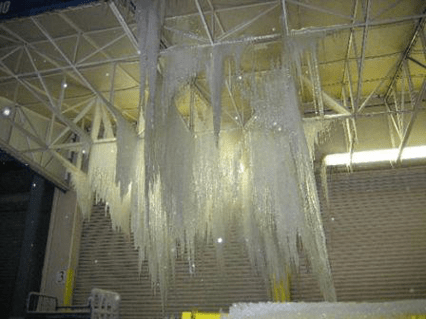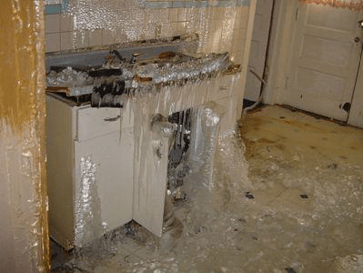Every winter, thousands of commercial buildings, industrial facilities, and homes experience major damage because of frozen pipes. Whether you are a facility manager, business owner, or homeowner, it is important to understand how to help prevent your pipes from freezing.
Why Do Pipes Freeze?

Water expands as it freezes. Most frequently, pipes freeze due to these three reasons:
- Quick drops in temperature
- Poor insulation
- Thermostat set too low
This expansion puts extreme pressure on both plastic and copper pipes which can cause them to burst. An 1/8" crack in a pipe can gush up to 250 gallons of water a day, causing flooding, serious structural damage, and the immediate potential for mold.
Frozen pipes can cause a huge amount of damage each year. Unlike natural disasters, this disaster is largely preventable. By taking a few simple precautions, you can help save yourself and your business the mess, money, and aggravation frozen pipes cause.
Don't Let it Happen in the First Place
There are a number of preventative steps you can take to keep pipes from freezing. Here are a few simple steps:
- Insulate pipes in crawl spaces and attics, even if you are in a climate where freezing is uncommon. Exposed pipes are most susceptible to freezing. The more insulation you use, the better protected your pipes will be.
- Heat tape or thermostatically controlled heat cables can be used to wrap pipes. Be sure to use products approved by a testing organization such as Underwriters Laboratories. Use only for the intended purpose (exterior or interior) and closely follow all manufacturers' installation and operation instructions.
- Seal leaks that allow cold air inside near where pipes are located. Look for air leaks around electrical wiring, vents, and pipes, and use caulk or insulation to keep the cold out. With severe cold, even a tiny opening can let in enough cold air to cause a pipe to freeze.
- Disconnect outdoor hoses and use an indoor valve to shut off and drain water from pipes leading to outside faucets. This reduces the chance of freezing in the short span of pipes just inside the building.
When the Mercury Drops
Even if you've taken the right preventative steps, extreme weather conditions can still harm pipes. Here are a few more steps you can take:
- A trickle of hot and cold water might be all it takes to keep your pipes from freezing. Let warm water drip overnight, preferably from a faucet on an outside wall.
- Keep the thermostat set at the same temperature during both day and night. Drops in temperature overnight could be enough to freeze pipes.
- Open cabinet doors to allow heat to get to un-insulated pipes under sinks and appliances near exterior walls.
Before a Winter Vacation
Don't forget to think about your pipes in your home or business before you leave on vacation:
- Set the thermostat no lower than 55°F (12°C).
- It's a good idea to have someone check your home or business daily to make sure it's warm enough to prevent freezing.
- Shut off and drain your water system.
What To Do If Your Pipes Freeze?

What do you do if your pipes still freeze, despite your best preventative measures? Don't panic. Just because they're frozen doesn't mean they have burst. Here's what you can do:
- If you turn on your faucets and nothing comes out, leave the faucets turned on and call a plumber.
- Do not use electrical appliances in areas of standing water: you could be electrocuted.
- Never try to thaw a pipe with a torch or other open flame because it could cause a fire hazard.
- You may be able to thaw a frozen pipe with the warm air from a hairdryer. Start by warming the pipe as close to the faucet as possible, working towards the coldest section of the pipe.
- If your water pipes have already burst, turn off the water at the main shutoff valve and leave the water faucets turned on. Make sure your family and employees know where the water shutoff valve is and how to open and close it.
If you have any water emergency, please contact us 24/7/365. We are here to help!

